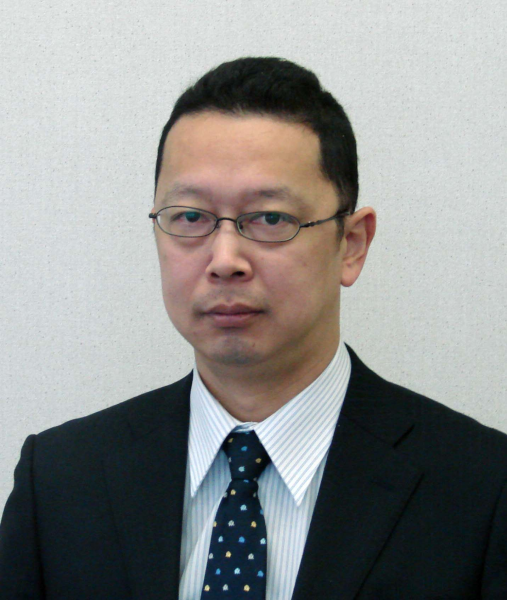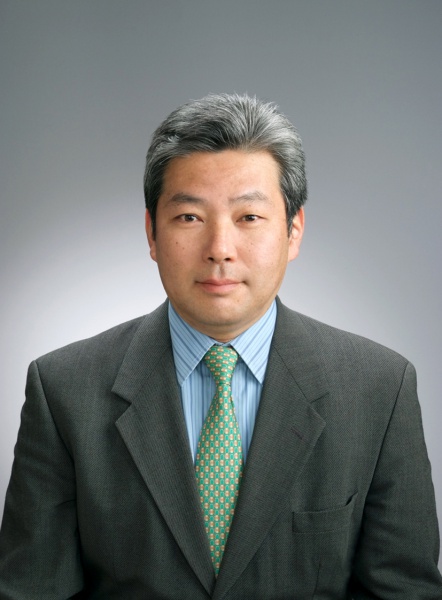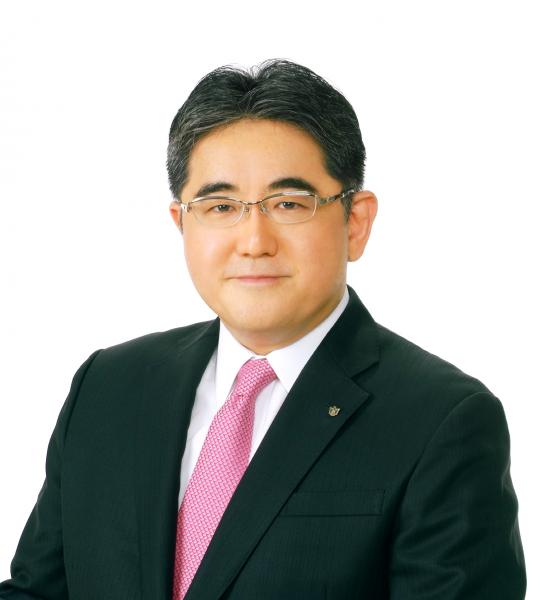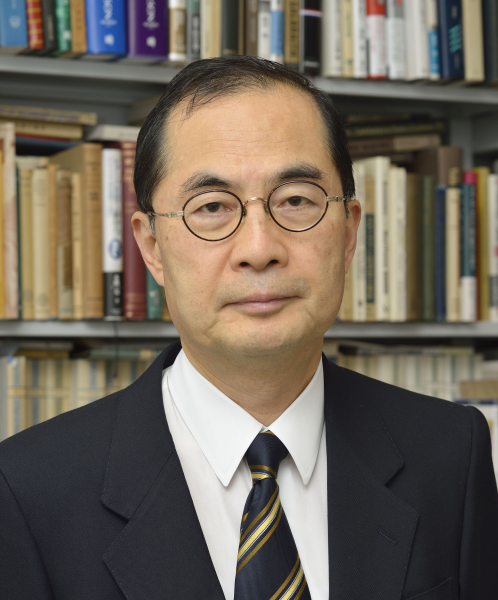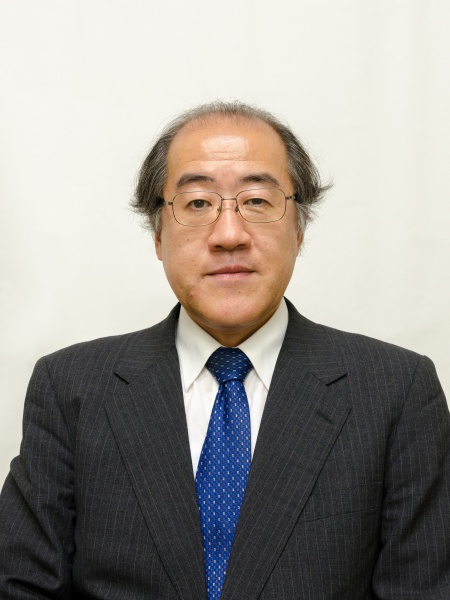New Developments in the Agricultural BusinessAbolishing the policy to reduce rice production is the first step toward a national economy based on agriculture: Toward agricultural innovation and business creation

YAMASHITA Kazuhito, Research Director, Canon Institute for Global Studies
Inaccurate perceptions about agriculture
With respect to agriculture, there is the common perception that large-scale farmers run their modern agricultural operations by using a lot of fertilizer and chemicals, while poor small farmers engage in environmentally friendly agriculture, and that Japan can’t compete with agriculture in the United States and Australia due to its small land area and the scale of its agricultural operations.
The agricultural industry and certain experts claim that this is why Japan’s agriculture, especially its small farmers, must be protected, and that expanding the scale of farming operations to improve efficiency or for Japan to join the Trans-Pacific Partnership (TPP) is out of the question.
However, there are no poor small farmers in Japan today. Small farmers are employed at other jobs and do their farming on the side, thus earning more than working-class households. Since they don’t depend on their agricultural earnings, they don’t need to make serious agricultural efforts such as expanding the scale of their operations. That’s why the scale of their farms remains small. Yet just because their agricultural operations are small doesn’t mean that farmers’ earnings are limited.
Small farmers who have other jobs only do their agricultural work on weekends. As they can’t spend a lot of time on farming, they use a lot of agricultural chemical insecticide to deal with weeds. According to a 2000 statistical survey, only 20% of average rice farmers cultivating less than one hectare engaged in environmentally friendly agriculture, while more than 50% of farmers cultivating 10 hectares or more practiced
environmental agriculture. Combined agricultural operations that cultivate rice, vegetables, fruit, and livestock help to reduce the consumption of chemicals. They turn animal manure and plant residue into compost to save on chemical fertilizers and prevent pests, reducing the consumption of agricultural chemicals. However, such practices can’t be done on the side.
With regard to scale, the farmland area per agricultural household in the European Union is six times that in Japan. The same area in the United States and Australia is 75 times and 1,309 times as large as Japan, respectively. A larger scale means lower costs if other thing are equal, but scale alone is not the most important factor. The farmland area per agricultural household in the United States, the world’s largest exporter of agricultural produce, is only 1/17th of that in Australia. How fertile the soil is makes a difference in the yield per unit area of farmland. In Australia, the soil is so unproductive that cattle are grazed on grassland. In the United States, corn (maize) is the main agricultural product. Australia’s wheat yield per unit area of farmland is one-fifth that of the UK. This means that one hectare of wheat in Great Britain is comparable to five hectares of wheat in Australia in terms of wheat production.
When we think about competitiveness, quality is a key factor in addition to cost. In the car market, there are high-end cars such as Lexus as well as low-end cars such as light motor vehicles. Similarly, there are huge differences in quality among agricultural products. Japanese rice is highly regarded in the international market. In Hong Kong, the price of the koshihikari variety of rice produced in Japan is 60% higher than that produced in California and 2.5 times higher than that produced in China. It is natural for high-end cars like Lexus to be higher in both cost and price than light motor vehicles. Most of the rice that is traded in the world goes to low-income countries in Africa, South Asia, and others. Only 1%, or 300,000 metric tons, of globally traded rice can rival the 8 million metric tons of rice produced in Japan.
A formula for agricultural success
Japan’s overall agricultural production has been decreasing since it hit its peak of 11,700 billion yen in 1984. In 2011, this figure stood at 8,200 billion yen, which is about two-thirds of its peak level. Among other agricultural products, rice production has declined significantly. In 1960, rice made up 50% of total agricultural production. In 2010, this percentage ultimately fell below 20%. Furthermore, the percentage of elderly farmers, aged 65 and older, has risen from 10% in 1960 to 60% today. Given that agricultural earnings have fallen and farmers’ children are not taking over the business from their parents, farmers today have no choice but to continue their agricultural operations. Therefore, the farming population is aging. And the inability to increase their earnings has led farmers to give up farming. In 2010, there were 400,000 hectares of abandoned farmland, equivalent to the area of Saitama or Shiga Prefecture.
However, amid this shrinking of agriculture, in 2010 there were as many as 5,577 agricultural operators whose agricultural produce sales exceeded 100 million yen. While farming enterprises experiencing poor sales are shrinking overall, those in this group alone grew 9.5% from 2005 to 2010. Some farmers have even started exporting their produce.
In any industry, a business’s profits are calculated by subtracting its costs from its sales,
which are calculated by multiplying the price of its goods by the sales quantity. This means that profits can be increased by either raising the price, increasing the sales volume, or reducing costs. Successful farmers practice one or more of these methods. Those in the agricultural field argue that agriculture is different from industry, as it is susceptible to natural conditions, but this management principle is common to all industries.
Let’s take a look at price and sales quantity. The production and sales volume of individual farmers make up a small percentage of the overall supply to the market. This suggests that increasing the sales volume by individual farmers won’t help to lower prices. This is the advantage of agriculture. It is different from an industrial sector which has a market structure centered around large companies.
Of course, regarding agricultural produce, it is possible to raise prices by adding value through the organic farming and processing of agricultural produce. However, even the price of rare goods will fall if they are produced in large quantities by a lot of farmers. Some argue that producing value-added products is the only way for agriculture to survive, but this isn’t true if you consider the relationship between supply and demand. In this regard, improving the taste of rice has tended to be the goal. To achieve high revenues, however, a group of farmers will specialize in rice varieties of average taste but with a high yield per unit area. Restaurants have a high demand for this kind of rice. This business model places a priority on quantity rather than on price.
Some have proposed combining agriculture with processing and services to increase the added value of agricultural produce. This approach is commonly referred to in Japan as the sixth industry, for which processing and distribution of agricultural products by farmers themselves as well as agritourism are promoted. Farmers, who are non-professionals with regard to processing and services, aren’t expected to be successful at something that even professional processors fail at. If they can produce rice cakes from rice in winter, it may be helpful for evening out their work, but not helpful for anything else.
Another decisive factor with respect to revenues is the cost per metric ton of agricultural produce, which is calculated by dividing the cost of production including that of fertilizer, chemicals, and agricultural machinery per unit area of farmland by the yield per unit area of land. This implies that costs could be reduced by keeping the prices of agricultural materials low, by increasing the scale of cultivation to reduce the cost per unit area of farmland, or by increasing the yield per unit area by, for example, improving the variety.
Let’s focus our attention now on some specific examples of farmers who have managed to increase their revenues. These include a farmer who started a business collecting agricultural produce who obtained local information about an owner’s intended use of farmland and succeeded in expanding the scale of his business by accumulating farmland; a farmer who imports secondhand machinery and agricultural materials from overseas to reduce production costs; a farmer who introduced a special cultivation method for Japanese yams to achieve a yield per unit area that is at least six times higher than the average level; a farmer who grows different vegetables with short cultivation periods many times a year to attain a higher yield per unit area; a farmer who delivers burdock roots (gobo) cut in half to increase sales to supermarkets, as a full-sized burdock root is too long for a plastic bag to carry; a farmer who only produces vegetable seedlings to earn hundreds of millions of yen from just a few hectares of farmland; and a farmer who sells processed vegetables when the price of fresh vegetables is lower than usual.
People’s eating habits today are characterized by a dependency on and the resulting expansion of food services outside the home, such as restaurants and prepared food businesses. Among both younger and older generations, the number of single-member households is increasing. For these, it is less wasteful and more reasonable to purchase prepared food than to buy a full-size amount of carrots, cabbages, and other vegetables and prepare meals with them. Curved cucumbers look bad and don’t sell in supermarkets, but once they are cut, they are no different from straight ones. One farm business approach targets restaurants and prepared food businesses. In contrast, there is a successful farmer who sells smaller vegetables, which helps to reduce the food preparation costs of single-member households.
One successful model, which agricultural associations hate, takes advantage of globalization. Large apples are well received in Japan, but when they were exported to Great Britain, they proved to be unpopular there. So an apple producer made a last-ditch effort to send smaller apples, which are unpopular in Japan, and received high marks. Apple farmers naturally produce many different sizes of apples, ranging from large to small. The producer in question succeeded in boosting sales by selling the large ones in Japan and the small ones in the UK.
With respect to the international division of labor, in one approach, seedlings production of flowers, which requires massive labor, is done overseas and the seedlings are imported into Japan, where they are grown into flowers.
The potential of Japanese agriculture
Japan is believed to be unsuitable for agriculture due to its small land area, even though it has a wide variety of plants as well as natural conditions suited to growing crops. Even in mountainous areas with small terraced farm plots, agriculture has great potential. Cultivating cucumbers and other vegetables doesn’t require a vast amount of farmland. One very profitable farm product, the Japanese horseradish (wasabi) is suited to cool mountainous areas at high altitudes. Taking advantage of the daily fluctuations in temperature, Uonuma in Niigata Prefecture and other areas produces good-tasting, high-quality rice. Flowers come in vivid colors there. In mountainous regions, there are ways of producing high-value-added agricultural products by capitalizing on the climate.
There is a huge difference in the agricultural workload between the busy and the idle seasons. It is therefore challenging to maintain an appropriate workforce level throughout the year. This is a major characteristic of agriculture that makes it different from industry. In rice farming, for example, labor is concentrated in the rice planting and rice harvesting periods. If workers were hired to meet demand in the busy seasons, they would be idle in the other seasons and a huge cost burden would be incurred.
However, mountainous regions have different altitudes. Farmers can work for two to three months each for rice planting and rice harvesting in those regions, while farmers have to finish their work in only one to two weeks in flat areas. Taking advantage of this, one farming couple has a 10–30 hectare plot in a mountainous region. That is a lot larger than the average farmland area for rice producers in 46 prefectures (excluding Hokkaido), which is 0.7 hectares. Labor can be distributed throughout the year by processing the rice into rice cakes and other products in winter or by marketing the rice to retailers, for example. This is more cost efficient than farming a 10-hectare plot in Hokkaido, where the farmland is flat but farming operations must be done in a short period of time.
With respect to vegetable farming, a company in Tottori Prefecture that was originally a wholesaler of vegetables and fruit established a 220-hectare farm based around the Japanese white radish (daikon), capitalizing on the 800-meter difference in altitude from reclaimed Nakaumi land to the foot of Mt. Daisen. It supplies daikon radishes to nationwide convenience store chains for the Japanese-style hot pot known as oden.
The Japanese archipelago is long in a north-south direction. Taking advantage of this characteristic, one enterprise engages in an almost corporate style of agricultural management. As it owns a number of farms that are scattered around the country, it moves its workforce and equipment in stages from its southern farms to its northern ones to distribute its labor and to improve the operation rate of its equipment to reduce costs.
Aside from exploiting differences in altitude, it is possible to even out the agricultural workload by cultivating early-, mid- and late-season varieties, by mixing different strains, by growing outdoor and indoor crops, or by growing rice along with vegetables and fruit. One beef farmer also engages in rice farming so he can use the manure in his rice paddies to cut fertilizer costs and use the rice straw as feed.
Leaving aside those agricultural leaders who highlight the differences between agriculture and industry, some farmers have successfully distributed their labor and brought their agricultural practices closer to the kind of production seen in the industrial sector.
Taking advantage of leading-edge technologies
Agriculture is not that different from industry. Postwar agriculture has introduced industrial products, such as agricultural machinery, chemical fertilizers, and pesticides. Especially today, leading agricultural operations have been aggressively introducing information technologies and other industrial technologies.
The productivity of farmland is uneven. It is possible to reduce unnecessary costs by dividing farmland into small sections and applying the necessary amount of fertilizer to the areas where it is needed. More specifically, a global positioning system (GPS) can be used to accurately measure the position and area of the farmland. The results of a soil component analysis using a soil sensor and the findings of a nitrogen sensor analysis of the color of crop leaves can be plotted on a map to adjust the fertilizer in each small section. In addition, pesticide can be sprayed without waste by equipping the farmland with robots capable of detecting subtle changes in weather conditions and collecting this data to forecast an outbreak of pests. It is therefore possible to slash costs for agricultural materials and reduce uneven growth. This will lead to higher yields and higher quality produce.
Furthermore, in Japan, natural conditions vary slightly from region to region. One system that is being studied will bring together the local agricultural technologies that enthusiastic farmers have acquired to propose solutions if needed in the event of a change in weather conditions.
Today, farmers must take full advantage of information technologies and other leading technologies. It is too costly for farms with a scale below a certain level to introduce them.
The great potential of rice
In Japanese agriculture, rice farming is notably on the decline, but this agricultural product outshines the rest of the world in terms of its quality. However, the policy of cutting rice production to keep the price high has prevented Japan’s rice farming from being price competitive. Discontinuing this policy could turn Japan into a major rice exporter.
After deciding to cut back on rice production in 1970, improving varieties to increase the yield per unit of land area became taboo among national and prefectural researchers. Now, Japan’s average rice yield per unit of land area is as much as 40% below rice production in California. If this policy is discontinued and the yield per unit of land area is raised to the level of California’s rice production, the cost will be cut by two-sevenths. One rice variety that is superior to California rice in its yield per unit of land area has already been developed in the private sector and is being grown by some farmers. An agricultural cooperative that supplies seedlings to general farmers benefits from the high rice prices based on the policy to reduce rice production, so it has no intention of adopting any seed of this variety or similar.
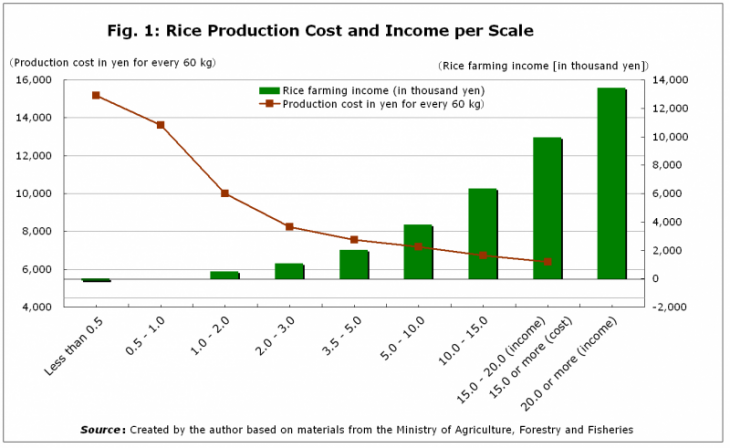
Under these conditions of high rice prices, small part-time farmers have remained in the rice industry. In non-rice farming, full-time farmers living off their agriculture comprise over 80% of sales, while the sales share of rice farming is less than 40%. If the policy to cut rice production is abolished, resulting in lower rice prices, part-time farmers will lease their farmland to others. If the beneficiaries of direct payment are limited to full-time farmers, they will be better able to pay their land rent. Thus, farmland will be concentrated in the hands of full-time farmers, and the scale of their farming will grow. An increase in scale means reduced costs. The cost of cultivating 15 hectares or more amounts to 6,500 yen per 60 kilograms. If the yield per unit of land area rises to that of California rice as a result of discontinuing the policy to reduce rice production, costs will fall to around 4,500 yen, which is less than half the national average rice production cost of 9,800 yen.
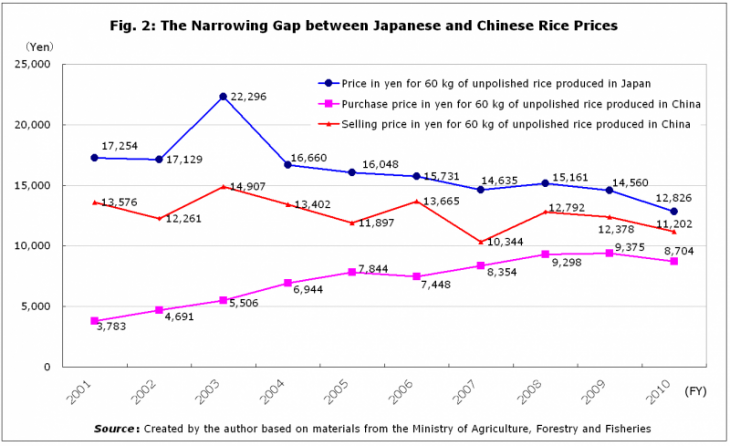
Fig. 2 shows the price of rice produced in China and imported by Japan. The line in the middle represents the price at which this rice is sold in Japan. The difference between the top line, which represents the price of rice produced in Japan, and the line in the middle reflects the difference in quality. In addition, the 13,000 yen price for the Japan-produced rice was the result of a policy to reduce the volume of supply. If cutting back on rice production is abolished, the price level will drop to around 8,000 yen, falling below the level of the China-produced rice. So, no tariff will be required. On the other hand, while it exports rice to Japan, China faces the issue of a 3.5-fold per capita income difference between the citizens in its urban areas and those in rural areas, which constitutes its biggest internal affairs problem. As China addresses this issue, labor costs in China’s rural areas will rise, and so will the price of its agricultural produce. Therefore, Japan’s agricultural produce will be more competitive in terms of price.
Suppose the price of Japanese rice fell to 8,000 yen while the China-produced rice price rose to 13,000 yen. Then, trading firms would earn profits by purchasing rice at 8,000 yen in the Japanese market and exporting it at 13,000 yen. As a result, domestic supply would fall and domestic prices would rise to the level of the export price. This would increase domestic rice production and agricultural income would more than double.
In recent years, the price differences between the domestic and overseas markets have narrowed. Even at the current price level, some producers have already started exporting their rice to Taiwan, Hong Kong, and other destinations. Japanese rice will be unrivaled if it can achieve price competitiveness after expanding the scale of its cultivation and improving the yield per unit of land area in addition to its world-leading quality. Abolishing the policy to cut rice production will be the first step toward a national economy based on agriculture.
Translated from “’Nogyo Bijinsesu’ no Atarashii Tenkai: ‘Gentan Haishi’ koso Nogyo-Rikkoku eno Daiippo: Nogyo Kakushin’ to ‘Bijinesu Sozo’ notameni (New Developments in the Agricultural Business ― ‘Abolishing the policy to reduce rice production is the first step toward a national economy based on agriculture: Toward agricultural innovation and business creation),” OMNI-MANAGEMENT, November 2013, pp. 2-5. (Courtesy of Nippon Omni-Management Association) [November 2013]
